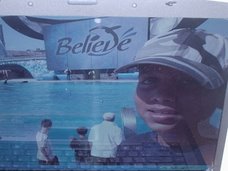Friday, November 16, 2007
What Diwali reminds
अब नहीं बनाती मां िमठाई दीवाली पर
हम सब भाई बहन खूब रगड़ रगड़ कर पूरा घर आंगन नहीं चमकाते
अब बड़े भाई िदन रात लग कर नहीं बनाते
बांस की खपिचयों और पन्नीदार कागजों से रंग िबरंगा कंदील
और हम भाग भाग कर घर के हर कोने अंतरे में
पानी में अच्छी तरह से िभगो कर रखे गए दीप नहीं जलाते
पूरा घर नहीं सजाते अपने अपने तरीके से।
अब बच्चे नहीं रोते पटाखों और फुलझिड़यों के िलए
िज़द नहीं करते नए कपड़े िदलाने के िलए और न ही
दीवाली की छुिट्टयों का बेसॄी से इंतजार करते हैं।
हम देर रात तक बाज़ार की रौनक देखने अब नहीं िनकलते और न ही
िमट्टी की रंग िबरंगी लआमी, ऐर दसू री चीजें लाते हैं
दीवाली पर लगने वाले बाजार से
अब हम नहीं लाते खील बताशे, देवी देवताओं के चमकीले कैलेंडर
और आले में रखने के िलए बड़े पेट वाला िमटी का कोई माधो।
अब हम दीवाली पर ढेर सारे काडर् नहीं भेजते
आते भी नहीं कहीं से
काडर् या िमलने जुलने वाले।
सब कुछ बदल गया है इस बीच
मां बेहद बूढ़ी हो गई है।
उससे मेहनत के काम नहीं हो पाते
वह तो बेचारी अपने गिठया की वजह से
पालथी मार कर बैठ भी नहीं पाती
कई बरस से वह जमीन पर पसर कर नहीं बैठी है।
नहीं गाए हैं उसने त्यौहारों के गीत।
और िफर वहां है ही कौन
िकसके िलए बनाए
ये सब खाने के िलए
अकेले बुड्ढे बुिढ़या के पाव भर िमठाई काफी।
कोइ भी दे जाता है।
वैसे भी अब कहां पचती है इतनी सी भी िमठाई
जब खुशी और बच्चे साथ न हों . . .
बड़े भाई भी अब बूढ़े होने की दहलीज पर हैं।
कौन करे ये सब झंझट
बच्चे ले आते हैं चाइनीज लिड़यां सःते में
और पूरा घर जग जग करने लगता है।
अब कोई भी िमट्टी के िखलौने नहीं खेलता
िमलते भी नहीं है शायद कहीं
देवी देवता भी अब चांदी और सोने के हो गए हैं।
या बहुत हुआ तो कागज की लुगदी के।
अब घर की दीवारों पर कैलेंडर लगाने की जगह नहीं बची है
वहां हुसैन, सूजा और सतीश गुजराल आ गए हैं
या िफर शाहरूख खान या ऐश्वयार् राय और िॄटनी ःपीयसर्
पापा . . .छी आप भी . . .
आज कल ये कैलेंडर घरों में कौन लगाता है
हम झोपड़पट्टी वाले थोड़े हैं
ये सब कबाड़ अब यहां नहीं चलेगा।
अब खील बताशे िसफर् बाजार में देख िलए जाते हैं
लाए नहीं जाते
िगफ्ट पैक साइ ृूट्स के चलते भला
और क्या लेना देना।
नहीं बनाई जाती घर में अब दस तरह की िमठाइयां
बहुत हुआ तो ॄजवासी के यहां से कुछ िमठाइयां मंगा लेंगे
होम िडलीवरी है उनकी।
कागजी सजावट के िदन लद गए
चलो चलते हैं सब िकसी मॉल में,
नया खुला है अमेिरकन डॉलर ःटोर
ले आते हैं कुछ चाइनीज आइटम
वहीं वापसी में मैकडोनाल्ड में कुछ खा लेंगे।
कौन बनाए इतनी शॉिपंग के बाद घर में खाना।
मैं देखता हूं
मेरे बच्चे अजीब तरह से दीवाली मनाते हैं।
एसएमएस भेज कर िवश करते हैं
हर त्यौहार के िलए पहले से बने बनाए
वही ईमेल काडर्
पूरी दिुनया में सबके बीच
फारवडर् होते रहते हैं।
अब नहीं आते नाते िरँतेदार दीपावली की बधाई देने
अलबत्ता डािकया, कूिरयरवाला, माली, वाचमैन और दसू रे सब
जरूर आते हैं िवश करने . . .नहीं . . .दीवाली की बख्शीश के िलए
और काम वाली बाई बोनस के िलए।
एक अजीब बात हो गई है
हमें पूजा की आरती याद ही नहीं आती।
कैसेट रखा है एक
हर पूजा के िलए उसमें ढेर सारी आरितयां हैं।
अब कोई उमंग नहीं उठती दीवाली के िलए
रंग िबरंगी जलती बुझती रौशिनयां आंखों में चुभती हैं
पटाखों का कानफोड़ू शोर देर तक सोने नहीं देता
आंखों में जलन सी मची रहती है।
कहीं जाने का मन नहीं होता, शैिफक इतना िक बस . . .
अब तो यही मन करता है
दीवाली हो या नए साल का आगमन
इस बार भी छुिट्टयों पर कहीं दरू िनकल जाएं
अंडमान या पाटनी कोट की तरफ
इस सब गहमागहमी से दरू ।
कई बार सोचते भी हैं
चलो मां िपता की तरफ ही हो आएं
लेिकन शेनों की हालत देख कर रूह कांप उठती है
और हर बार टल जाता है घर की तरफ
इस दीपावली पर भी जाना।
फोन पर ही हाल चाल पूछ िलए जाते हैं और
शुरू हो जाती है पैिकंग
गोवा की ऑल इन्क्लूिसव
िशप के िलए।
Ñसूरज ूकाश
Thursday, October 25, 2007
India's traditional knowledge
Deprived of access to resources and economic means of livelihood,
One way to ensure this would be to add value to this knowledge base, to generate commercial as well as non-commercial returns and to ensure that people have a reasonable stake and share in the income so generated. Unless some value addition takes place locally, the trickle down of the benefits is generally low. In addition, if the providers of knowledge and conservators of resources do not have a stake in the institutions, which add value to their knowledge and creativity, it is unlikely that their gains will be durable and substantial.
social needs and challenging innovation
It was in 1975 while moving about in a boat in flood-ravaged Champaran village in Bihar, India; that Mr. Saidullah felt the need to create a bicycle that could be paddled across water. He named the product Noor, after his wife. The vehicle is a conventional bicycle with four rectangular floats attached to the wheel on four sides. Fan blades are attached in radial fashion to the spokes of the rear wheel. When the cyclist pedals in water, the blades attached to the rear wheel rotate and force water backwards, pushing the bicycle forward.
Video:
http://www.youtube.com/watch?v=REx9rMDbqRg
http://video.google.com/videoplay?docid=7062940046917388113&q=bicycle+for+flood&total=92&start=0&num=10&so=0&type=search&plindex=1
Monday, October 8, 2007
What Innovations makes?
Monday, September 17, 2007
http://sristi.org
Intellectual property rights provide only one set of incentives, among many, that are possible and necessary for encouraging creativity and innovation at grassroots, besides conservation of biodiversity. Material and non-material incentives for individuals and groups have to be combined in a proper portfolio, matching the specific knowledge and resource context. The incentives for individual experts cannot be at par with that of the communities. However, if communities don’t conserve the resources, individuals will not be able to access, experiment, innovate, develop solutions and specialise. Therefore, there has to be a proper recognition of the rights of communities as well as individuals.
A policy framework must recognise that the nature of innovations in traditional knowledge brought about by individuals can become community- wide or public domain knowledge. My suggestions for policy reforms are based on the activities of our Honey Bee Network over the past 16 years, pursued by various voluntary organisations who have contributed towards a database on innovations and traditional knowledge.
The experience of Society for Research and Initiatives for Sustainable Technologies and Institutions (Sristi), Grassroots Innovations Augmentation Network (Gian) and the National Innovation Foundation (NIF) and the National Micro Venture Innovation Fund managed by NIF, has been drawn upon in advocating policy changes, nationally and internationally.
To reduce transaction costs of inventors, innovators and traditional knowledge holders, the National Register of Grassroots Innovations and Traditional Knowledge, being developed by NIF, may be accorded legal protection, such that disclosure to NIF entitles knowledge-holders a minimum protection, if the knowledge is not already in public domain. The registry should have a grace period for disclosure, so that protect- ion can be not only for knowledge produced within one year of its earlier disclosure, but perhaps during the past five to 10 years. India should plead for a like international registry.
Honey Bee Network has experimented with prior informed consent (PIC) extensively for over a decade. NIF has modified the framework and has developed a two-stage process. In stage one, consent is sought for sharing, adding value or blending the knowledge with other innovations/ TK practices, etc. In stage two, if something useful is considered possible with or without value addition, then a benefit-sharing accord
Water for Future: A civil war in the corner
Generating new insights into practiceNew information on innovative irrigation management practices has been developed. Within the Improving the Precision of Irrigation project, the use of partial rootzone drying and regulated deficit irrigation practices have been assessed in crops from pears to cotton. The Open Hydroponics project has examined the intensive, innovative horticultural management practice which uses almost continuous irrigation with nutrient enriched water. The irrigation and nutrition management principles used by open hydroponics systems can be efficient but the level of efficiency is directly linked to the implementation of good management. A preliminary ecological risk assessment identified several major risks to sensitive catchments from open hydroponics. The Improving the Precision of Irrigation project is developing the tools and frameworks for assessing and determining the importance of crop variation across the paddock. Based on this, the potential of adapting irrigation systems to deliver variable rate irrigation applications can be assessed within both biophysical and profitability frameworks.
Tools for improving performanceAs the value of water increases, growers and advisors are being asked to understand and manage their irrigation storage and distribution systems with greater precision. New tools are required to support these decisions. The Improving the Precision of Irrigation project has provided an economic ready reckoner to assist irrigators evaluate alternative evaporation reduction strategies for on-farm water storages. At the farm level, the project has delivered a tool for choosing the optimal irrigation system for dairy farms. In the paddock, tools have been developed for improving grower management of centre pivots and lateral move irrigation machines and refining performance of travelling gun irrigation machines.
Global mood: Biotechnology innovation India
While looking for additional opportunities in the United States and Europe, Dishman is also venturing into API production in Saudi Arabia and considering options in Africa. Dishman has established a sales presence in Japan as well. "Today, 90% of our business is generated around the world with 10% in the US, but with our acquisition of Carbogen-Amcis, we expect deeper changes," said Vyas.
Wednesday, July 11, 2007
Motto of Creating enterpreneurs
Evaluating business opportunities and risks
Creating business plans
Designing and managing new ventures
Launching technology-based businesses
Structuring finances
Implementing marketing and strategic planning initiatives
Providing consulting services
Understanding the legal issues of entrepreneurship
Identifying international entrepreneurship trends and developments
WE solicits the best business plans from students, alumni, and faculty at all higher education/graduate-level institutions from India. The goals of the our initiative is:
Support students, alumni, and faculty researchers in their entrepreneurial endeavors.
Encourage the commercialization of promising ideas and the development of new ventures.
Build bridges between our Center and the Indian business community.
Add a special incentive to new business startups
Serve as a catalyst for economic development and new business growth in India and especially in Bihar.
Economic transport and business idea
These rickshaws are owned by the organisation but are driven by persons found eligible by Sammaan. Rickshaws have been given for free. The entire earning from the rides goes to the rickshaw driver while the profit from the sales of water, soft drinks, etc, gets shared between Sammaan and the driver.
The organisation gives the driver free uniform, identity card, bank accounts and an insurance cover of Rs 2 lakh. However, the driver needs to pay a maintenance fee of Rs 10 a day for the rickshaw. A passenger travelling in a cycle rickshaw can now have the luxury of sipping a Coke or Pepsi apart from listening to music via a headphone while he travels.
Moreover, he also gets an insurance cover of Rs 1 lakh. In addition, these rickshaws are becoming an effective way of advertising and brand promotion for companies and are an emerging trend in outdoor media. The good news is that the fare charged for a ride in these rickshaws is the same as in a regular rickshaw.
"We are also in advanced talks with Zandu Pharmaceuticals, Coca Cola and Dabur, and are hopeful of getting advertising contracts from them," said Irfan Alam, director of Sammaan.
The organisation expects Rs 10,000-15,000 a year from a single rickshaw. It has signed a contract worth Rs 1.26 crore with Priya Gold to advertise its brands on 1,500 rickshaws for a period of one year.
Sammaan currently has about 100 rickshaws running in Noida and Ghaziabad, and another 100 in Patna. By February, it will have rickshaws running in Agra, Meerut, Gurgaon and Chandigarh.
Sammaan also plans to install telephones in these rickshaws, which will add to the income of the driver as well as the organisation. It is also considering addition of value added services like payments of electricity and telephone bills through the rickshaw driver. Powered by
Creative mind
The human mind has long fascinated psychologists
Helen Briggs BBC News Online
Australian scientists say they have created a "thinking cap" that will stimulate creative powers.
The invention raises the possibility of being able to unlock one's inner genius by reawakening dormant parts of the brain.
This shock finding will challenge many of our conventional views regarding creativity
Steve Williams, Institute of Psychiatry It is based on the idea that we all have the sorts of extraordinary abilities usually associated with savants.
According to scientists at the Centre for the Mind in Sydney, these hidden talents can be stimulated using magnetism.
Professor Allan Snyder and colleague Elaine Mulcahy say tests on 17 volunteers show their device can improve drawing skills within 15 minutes.
They intend to submit their work for publication in a scientific journal.
The news, reported in Chemistry and Industry magazine, has been given a cautious welcome by experts in the UK.
'Unconscious skills'
Professor Steve Williams, of the Institute of Psychiatry in London, said Professor Snyder was a highly respected international scientist and he was looking forward to reading the scientific paper.
Many autistics are accomplished artistsHe told BBC News Online: "This shock finding that everyone might possess unconscious skills that can be 'switched on' with magnetic stimulation will challenge many of our conventional views regarding creativity."
The inspiration for the device comes from savant syndrome, a condition portrayed in the Hollywood film Rain Man.
Savants are extraordinarily gifted. They may have amazing memories or excel at maths, music or art. But they also have developmental disorders such as autism.
Mind state
One theory behind savant syndrome is that the right side of the brain overcompensates for damage to the left hemisphere.
The skills most often seen in savants are those associated with the right side.
Savant syndrome
Rare condition in which persons with various developmental disorders have astonishing abilities or talents
Savants also have a prodigious memory
Typical savant skills include music, art, and mathematical skills
About 10% of persons with autistic disorder have some savant skills According to Professor Snyder, it might be possible to train someone to access this state by controlling their brain waves.
David Potter of the National Autistic Society, a UK charity, said the research was fascinating.
"Some scientists believe that the essence of creativity is not a state of mind but an activity," he told BBC News Online.
"Whether Snyder and Mulcahy's research will enable the expression of savant skills without accompanying impairments remains to be seen."




